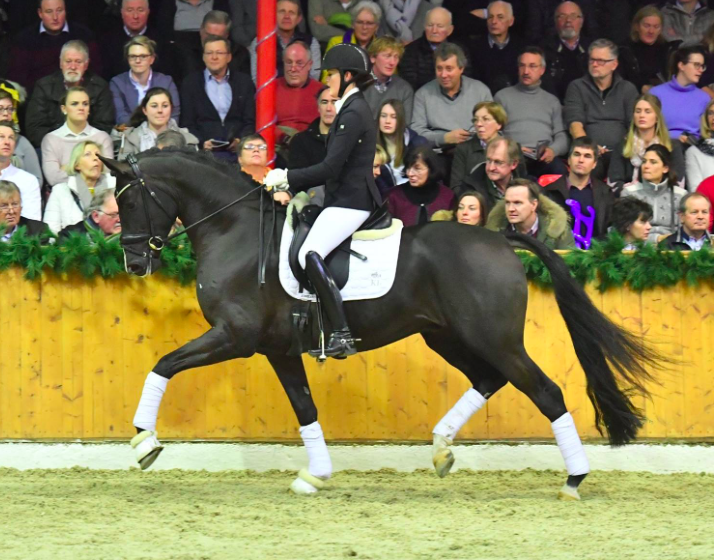Jean François Pignon is famous throughout Europe for his spectacular liberty acts, but he is also hugely in demand as a teacher for riders who really want to understand their horses better…
Rebecca Ashton interviews Jean François – Richard Dunwoody and Rebecca took the photos…
We receive the brightest welcome from Jean François’ wife Sylvie at their property in the heart of Provence. She escorts us out of the dry, summer heat and is soon showing us photos of Jean François working horses privately for the Queen at Windsor Castle. HRH is such a fan of the French horse trainer that he receives a Christmas card from her each year.
 Jean François is at the computer, searching files as he’s keen to show us the new show he has in the works, “Black and White” and he has some footage of it shot from a drone. His six black horses are all just two years old and already he’s playing with them. The way they came into the world is a story in itself. A local vet owned a “dangerous” stallion. It was either go and visit Jean François or be put down, so Jean François took him on, “It was very interesting working with him,” Jean François explains, “He was very sensible. If you stayed and moved with him, it was very interesting.” That’s a theme you hear a lot with the Frenchman. After all these years, he still finds the horses very interesting, there’s still something to learn from each one.
Jean François is at the computer, searching files as he’s keen to show us the new show he has in the works, “Black and White” and he has some footage of it shot from a drone. His six black horses are all just two years old and already he’s playing with them. The way they came into the world is a story in itself. A local vet owned a “dangerous” stallion. It was either go and visit Jean François or be put down, so Jean François took him on, “It was very interesting working with him,” Jean François explains, “He was very sensible. If you stayed and moved with him, it was very interesting.” That’s a theme you hear a lot with the Frenchman. After all these years, he still finds the horses very interesting, there’s still something to learn from each one.
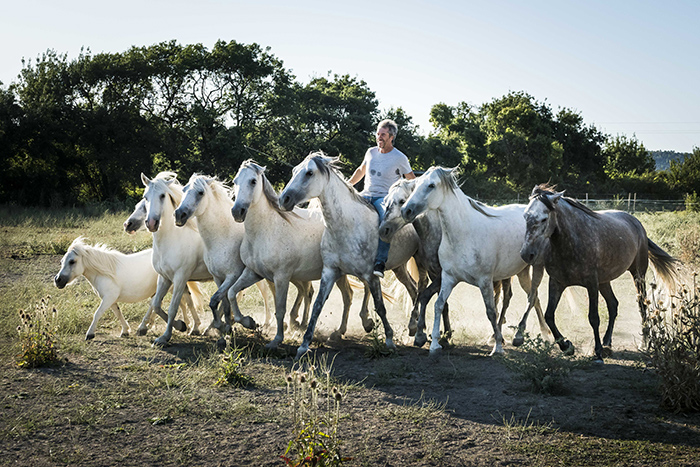 Needless to say, he changed the vet’s horse completely. As payment, he took some services from the stallion and ended up with six black foals. Hence the show, as they will join his already established team who are all white.
Needless to say, he changed the vet’s horse completely. As payment, he took some services from the stallion and ended up with six black foals. Hence the show, as they will join his already established team who are all white.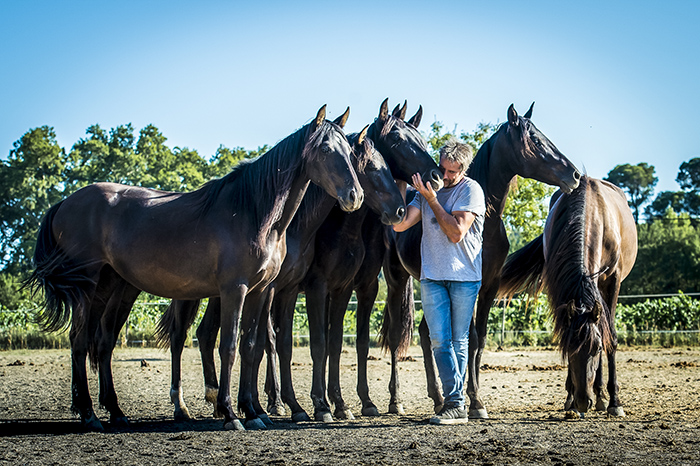
story continues below the advertisement
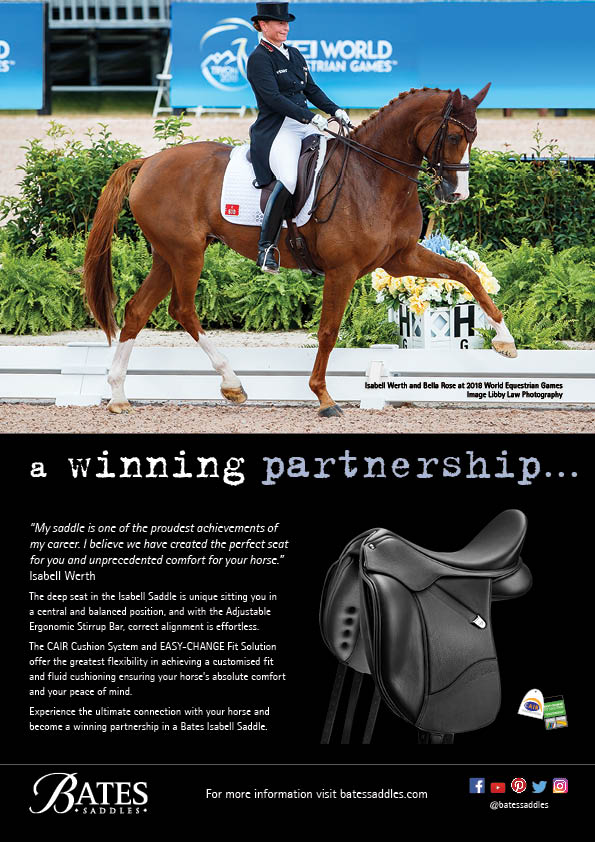
Horses entered the Pignon family with Jean François’ grandfather, who was a farmer and had a draught horse called Marquise. Jean François’ father was besotted with the mare and was heartbroken when she was sold. Later on, with a family and farm of his own, he decided once more that horses should become a part of his life and he bought Choupette, an eight year old mare in foal. But the real life changing moment was the purchase of Gazelle, a yearling filly who was assigned to the slaughterhouse. She was given to the 11 year old Jean François for Christmas and the two became inseparable, with the youngster’s passion turning from his beloved football to his equine friend. The young Jean François’ fascination with animals however was already in place before Gazelle’s arrival. He used to play with the sheep and get the lambs to follow him, studying their reactions and gaining their trust from trial and error. The larger sheep were also used by the Pignon children to hone riding skills before horses entered the frame!
Gazelle was just two when Jean François rode her to school and the mare proved to be a patient friend who tolerated much from her inexperienced rider. Of his three other brothers and sister, Frederic shared Jean François’ passion and as the two brothers got older, they began doing little performances at horse shows, doing acrobatics off horses, riding Roman style and doing liberty work.
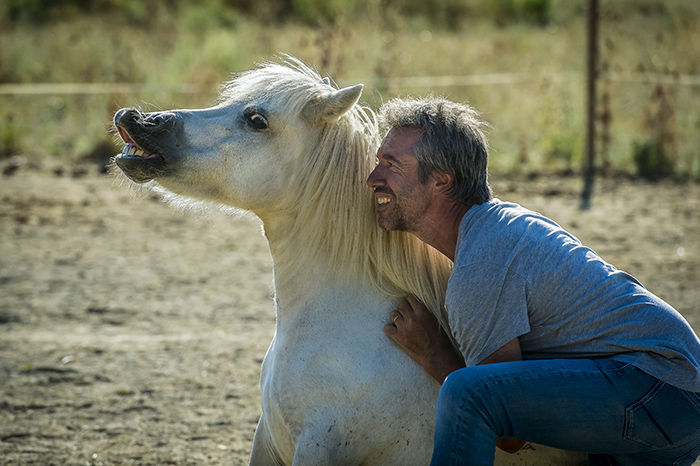 So as you can see, the six black youngsters aren’t the first horses he’s started so young. “The first time I played with foals in the show was for the Queen’s Jubilee in 2012.”
So as you can see, the six black youngsters aren’t the first horses he’s started so young. “The first time I played with foals in the show was for the Queen’s Jubilee in 2012.”
“My wife has a mare and a few years ago it had a foal, a colt. Normally I have just mares in my show because in the natural environment, you have mares together not the stallions. But then I thought, well you actually have mares and a stallion. When we had the little stallion, I thought well why not try and work the mares and stallion together in the show? Of course, we ended up having lots of babies! But it’s nice because we can play with the babies in the performance. It’s only a few minutes for the final and the audience love it.”
Are there ever nerves before a show? Does it ever go wrong? I’m interested to know. 
“I often improvise,” says Jean Francois, “Normally I prepare the choreography but in the show I adapt. If my horses are a little bit stressed, I take time. With the Queen, I had four minutes. It was too short with ten horses. Thirty minutes is ideal for me.”
“I did a show at Aachen in the big arena. It was a dream for me but also in that big arena, you have grass! There was a hot air balloon, aerial acrobats and a herd of thirty Camargue horses with foals. I had only nine minutes for this show.”
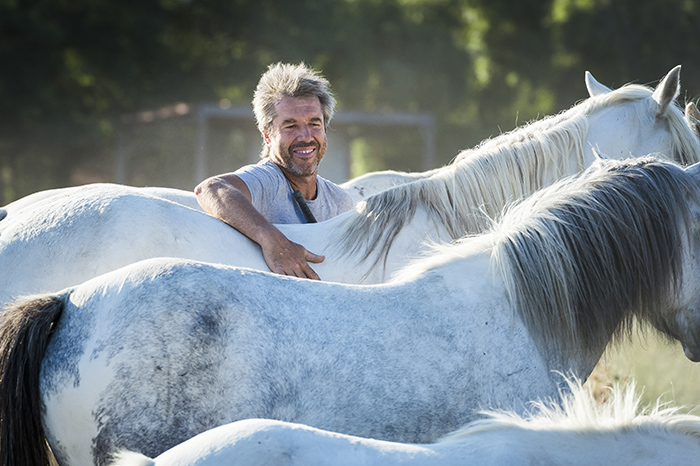 So how does he stay calm in that situation? “I pray! First I think it’s catastrophic, it’s not possible. But I spoke a little to the guy with the Camargue horses to keep them together. My horses went out directly but they galloped very quickly with the stress. So, I ran and my horses could see me and then I thought perhaps they will return with me and we can do some exercises. We did some exercises and it was cool.”
So how does he stay calm in that situation? “I pray! First I think it’s catastrophic, it’s not possible. But I spoke a little to the guy with the Camargue horses to keep them together. My horses went out directly but they galloped very quickly with the stress. So, I ran and my horses could see me and then I thought perhaps they will return with me and we can do some exercises. We did some exercises and it was cool.”
“That show was only white horses but a few days ago I was in Berlin in a big area with grass and I thought wow, grass a second time! There I had the black horses and it was terrific. The night before I wasn’t sure and I thought I would just use the white horses but then I thought, ok, I’ll try and if it doesn’t work, I’ll put the black horses out, but it was great.
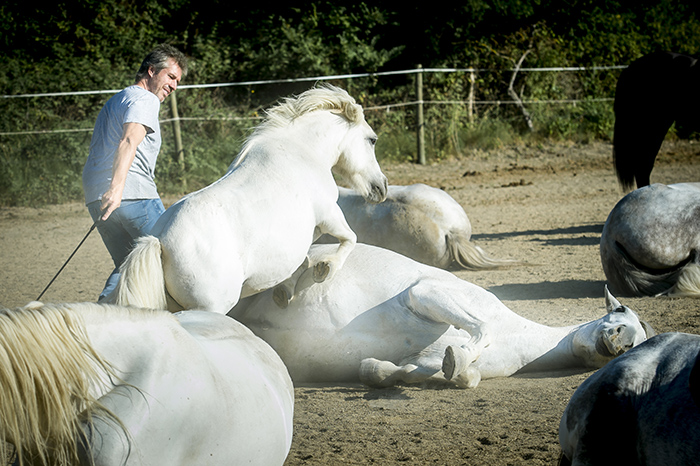
“Two hours before I let them go and eat grass and I prepared them. I thought perhaps after that they would be able to concentrate. During the two hours I played a little bit with the black ones. Just before my show there were fireworks so I thought, ok, it’s good experience! So two hours is a long time. Normally I just prepare for one hour so they can still concentrate, but I was very happy.”
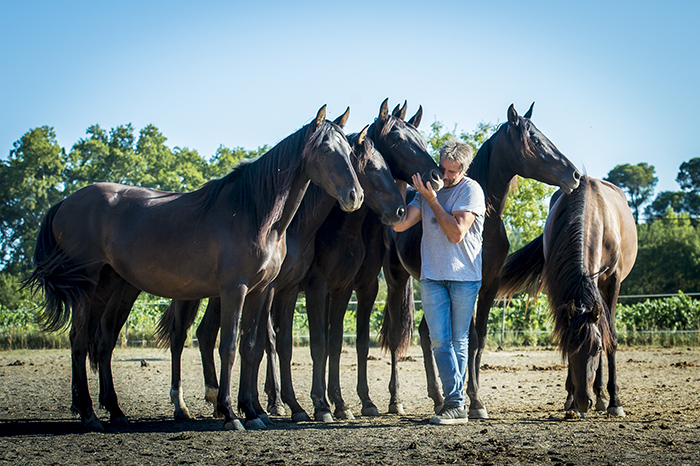 What does the preparation involve, I wonder.
What does the preparation involve, I wonder.
“I don’t know all the time. I just feel. I concentrate on them. I made a very, very good experience a few months ago in Patagonia. My project for this was to meet wild horses (Criollos) in the desert at a farm of 25,000ha. It was a big pleasure. My wife stayed at home so I had no problems at all to worry about. I could completely focus on the wild horses. I went out alone, no phone, just me and one cameraman for forty days.”
story continues below the advertisement
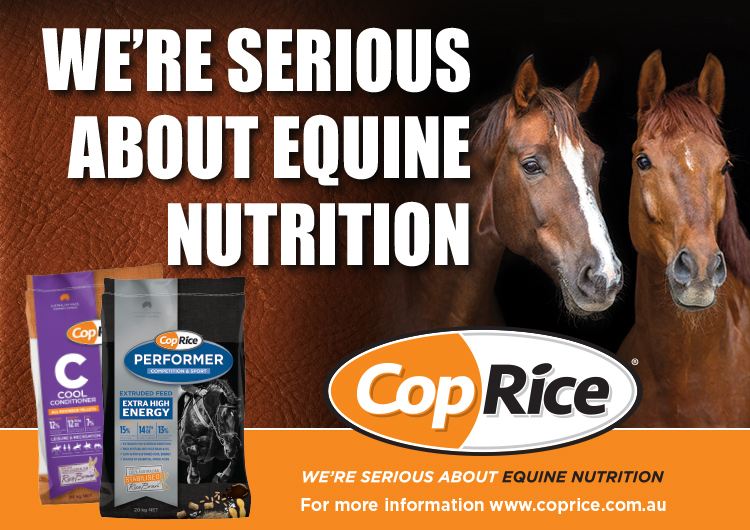
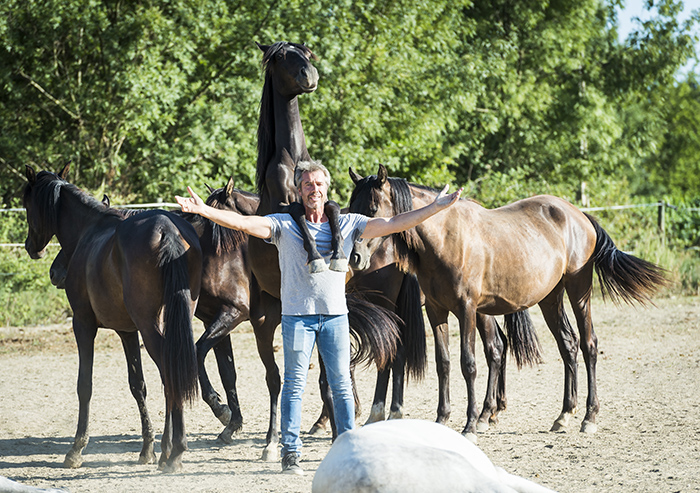
That sort of focused concentration on the animals is the Frechman’s happy place. “I am the very man for this,” he explains, “As I can only think of one thing at a time! When I was young, I liked to see horses together, sheep together, I liked to understand the animal. I was very young, seven years old, I made my first training experience with the sheep. I remember I’d say, ‘You stay there’ and it would move so I would bring it back and ask it to stay again and after a few days I would bah like a sheep and it would follow me. It made me so happy because normally a sheep would want to go with its mother. When my father bought his first horse, I wanted to try with her. I concentrated and made it follow me.”
Does Jean François think that’s missing a little bit in the top sport; if there should be more time spent building a relationship?
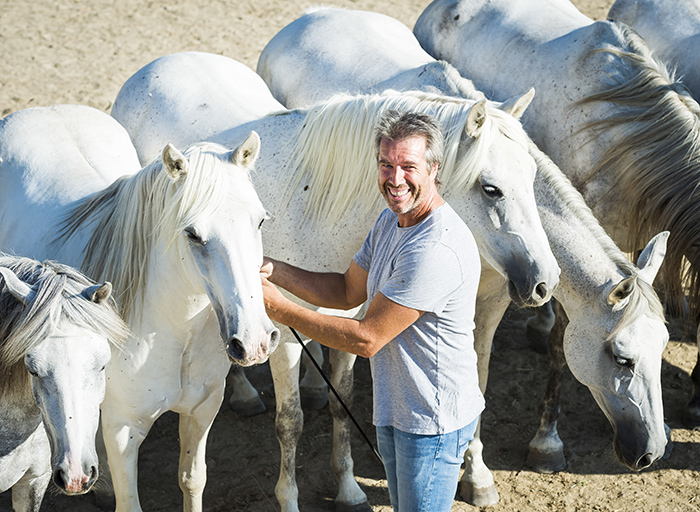
“Sometimes, because I know the jumping world with good riders like Bosty (Yves Roger Bost) and Kevin Staut and my good friend Michael Whitaker and John as well (and Jean François’ daughter Swana is a budding jumper herself). He once came to my home with a horse because it didn’t want to turn left and asked if I could help. I didn’t know but I know that if you have a good relationship with your horse, it’s much easier! Sometimes riders ask for my help. Michel Robert, I remember the first time we worked together. He said his horse had a big problem, it’s very afraid on course. So we trained together and he was very happy because he won afterwards!”
In all these training situations, one of the most important places to start according to Jean François is from a place of acceptance. This was made even clearer during his Patagonian trip. “Sometimes the horse presented itself to me and came to me with no stress and the next day I arrived with what I thought was the same body language and he wouldn’t come to me. So, one day is good, the next day not, so I try to understand. But what I do understand is that you must accept the situation. You understand that this situation is good or this one is bad, but either one, just accept it. Ok, it’s not easy to accept if it’s not good, but you do. With horses it’s not a vocal language but body language. I have long arms, it’s not normal! (At which point Jean-François is showing the length of his arms against the wall….”I’m like a monkey! It’s not King Kong, but…..”) I thought perhaps I can use this. So I use my hands and arms to give signals. I can put the horses where I want only with my hand. One horse in Patagonia, I could do this and the horse moved how I wanted and I turned to my cameraman and joked, ‘Look! He’s ready for my show!’”
 “To me it really highlights how important body language is with horses, how very subtle movements can be read by the horse.” This is also the reason Jean Francois was keen to work with wild, untouched horses, “The horses Patagonia don’t know humans so I started from zero. Here you have horses, when you take the whip, he goes and jumps or whatever, because he’s been trained like this. I think the body language is very important for horses but I think all horses can accept, clicking of the tongue, sugar. But the body language is the horse’s language. Ok, if I go to England, I must speak English, if I go with horses, I must speak horse. I don’t know why humans don’t think like this because clicking is not the horse’s language. He can understand and accept, but it’s not the best.”
“To me it really highlights how important body language is with horses, how very subtle movements can be read by the horse.” This is also the reason Jean Francois was keen to work with wild, untouched horses, “The horses Patagonia don’t know humans so I started from zero. Here you have horses, when you take the whip, he goes and jumps or whatever, because he’s been trained like this. I think the body language is very important for horses but I think all horses can accept, clicking of the tongue, sugar. But the body language is the horse’s language. Ok, if I go to England, I must speak English, if I go with horses, I must speak horse. I don’t know why humans don’t think like this because clicking is not the horse’s language. He can understand and accept, but it’s not the best.”
story continues below the advertisement
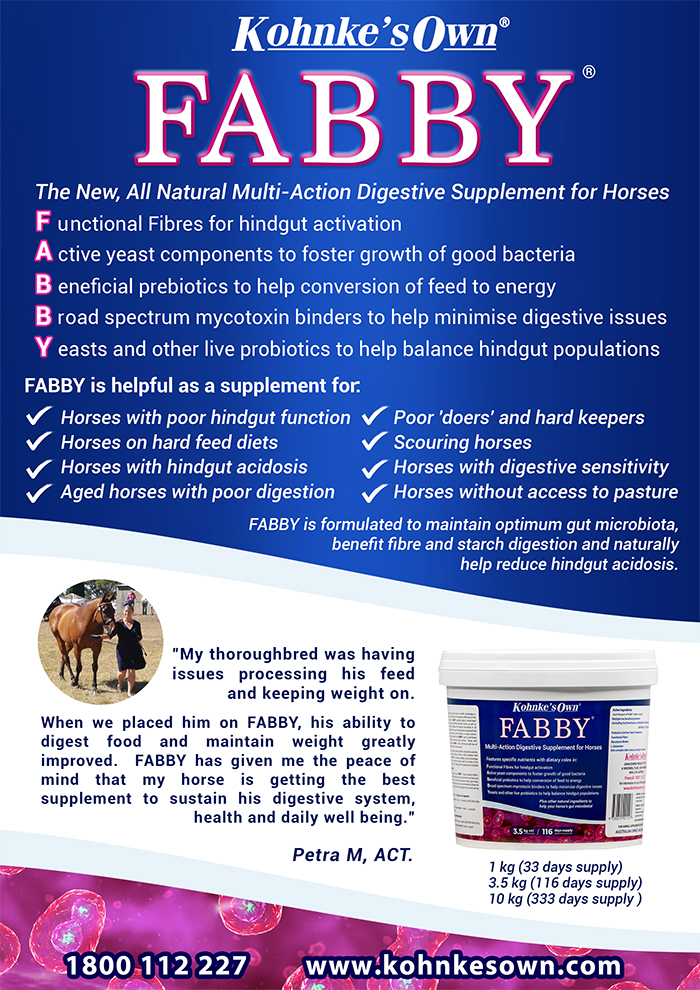
So, how can people be with their horses in a better way? He instructs, “First, you must learn to speak horse. It is not the same world, the human world and the horse world. In the human world, we use a voice. Horses no. When we all gather together, like here today, we don’t have a chief or a boss, everyone is the same level. There is no hierarchy. But horses, there is always a hierarchy. You can’t see horses together without this. It’s the first language. When horses meet, the first reaction is I’m number one or you are number one. When I say hello to a person, it’s a nice moment, but with horses, it’s not a nice moment. It’s a hard moment. They are testing the hierarchy from the start. It’s logical to speak the same language. After they know you are in charge, then it’s a nice moment between us. But people with their horses, they kiss them and treat them like their baby and the horse doesn’t understand that.”
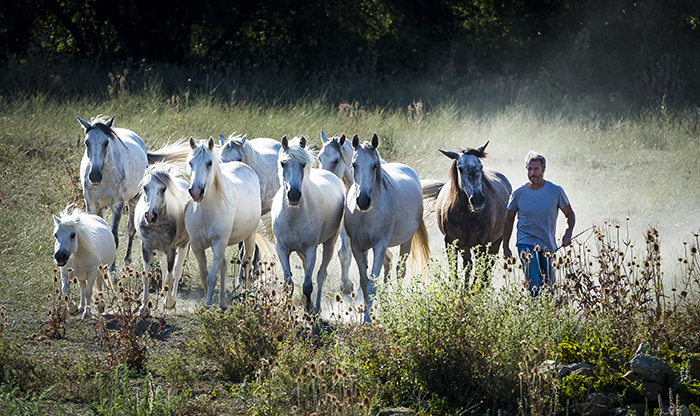
“I do think it would be wonderful if all future trainers spent a little time just contemplating a few horses out at pasture. There is so much to learn by observing their behaviour. Observation doesn’t cost anything, and it’s surely one of the best basics for horseman.”
What is the line between being cruel or just asking for respect? “For me it’s easy because I love God. So for me the system is natural. The human is above the horse. Naturally you have that position. You can see that in Patagonia. When I arrive, my position is above them, but the first thing I need to do is tell them, ok, I’m not dangerous so I can touch them. It’s not possible when I arrive because the horse fears the human. So, I have to tell them I’m not dangerous and the horses understand this step by step to make a good relationship. You can do it gently. You can be a friendly chief to the horse, not a cruel chief. You have to be just above the horse, not equal because the horse might think then, oh, I can be number one and push. If you let your horse push you, sometimes you are number two. That is not good for the horse. If you are going to control his stress, you have to be the chief. Now, if you teach the horse to push, it’s something you taught. He pushes when you say, now, not when he wants.” Jean Francois insists that the trainer must command respect from the beginning, or else it will become dangerous and the trainer will not be able to play with the horse later (this was an early lesson taught to him as a child by the family’s ram Pichoune!)
However, he recognises four very important requirements for a horse trainer: Calmness (but not softness), firmness, appropriateness (firmness without calmness and appropriateness becomes brutality) and love. “That is my method summed up in four words! The trainer is not a horse: a horse does not train its fellow creatures. The trainer is not a predator: a predator does not train its prey, either! The trainer is a human being: he naturally dominates animals.
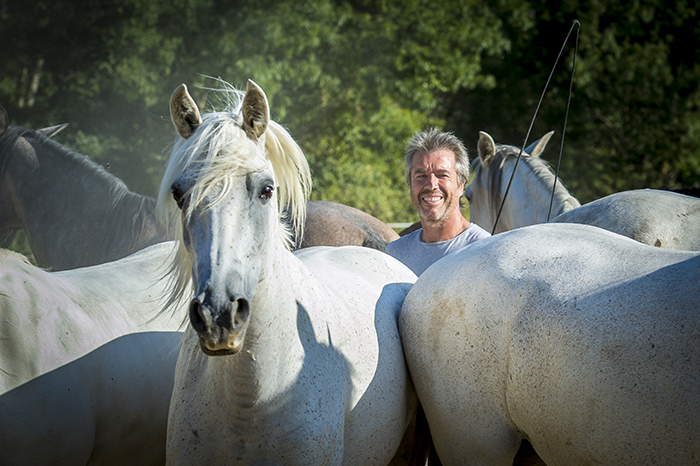
Jean François has a cheeky smile on his face as he shows us a photograph of himself lying down and his horse’s foot on his face. It’s quite amazing! How does he teach a horse to do that? “It’s actually not that difficult. If he knows you’re a good and friendly boss, he’ll do what you want. They will stay very relaxed, without stress. For me, all horses can make this exercise. If it’s with concentration and without stress, it’s ok.”
“People often think, my horse will like me if I give it a carrot or some sugar. No, this is the human world, not the horse’s world. After horses have played together, they don’t thank each other for a good time, they finish playing and go and eat grass. Anthropomorphism is a big mistake. It’s totally different. Love is very, very important. When your horse doesn’t respect you, you get angry. That’s not good for the relationship. For a good relationship, you are the boss, but you have to do it with love. When you say no, you don’t do it with aggression and a strong voice and aggressive body language. Then you are like a predator.”
That’s a lot of self control! “Yes, it’s not easy, even for me! Your first reaction is to say, ‘Hey!’ but no. You have to stop yourself. I had a clinic and the horse didn’t want to go to the trailer. He’s stressed. If I then get angry, I have two problems then rather than one, him and me. I have to stay relaxed and do it with love. In doing it, he trod on my foot, it was not comfortable for me, but I said ok, I keep going with love and five minutes later he went on the trailer. I’m sure if I had reacted with anger because he had trodden on my foot, it would have taken a lot longer.”
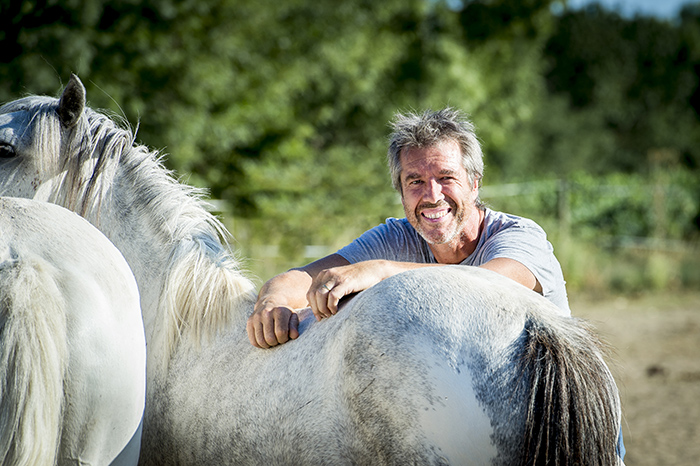
When things don’t go to plan, Jean Francois is always quick to say, “I was stupid,” but he thinks about what happened, analyses it and comes up with a solution. He truly is a thinking horseman. What’s even more interesting is that all his trainers have been the animals. He doesn’t really credit any humans with what he’s learnt over the years. “They are the best teachers for me. I always search to change or improve my technique. My dream is to do the show ‘Black and White’ without a whip. Today I need the whip. Sometimes I can do it without. It’s really something to communicate with 15 horses with just your hand. For me, that’s the best. Horses don’t pick up sticks to control each other.”
“Horses are vey sensible. When you take a whip, he knows immediately. He knows when I have it so I thought, what’s the difference? Perhaps it’s me as well. Maybe first he knows now I can reach him but also, maybe my body language is also different because I’m not the big boss with the whip. I don’t know. I think about this. Horses to me have x-ray vision. They can see and notice everything. They can see inside you. Humans cannot. The whip is not only an extension of your hand. Horses are not stupid, it’s more than that.”
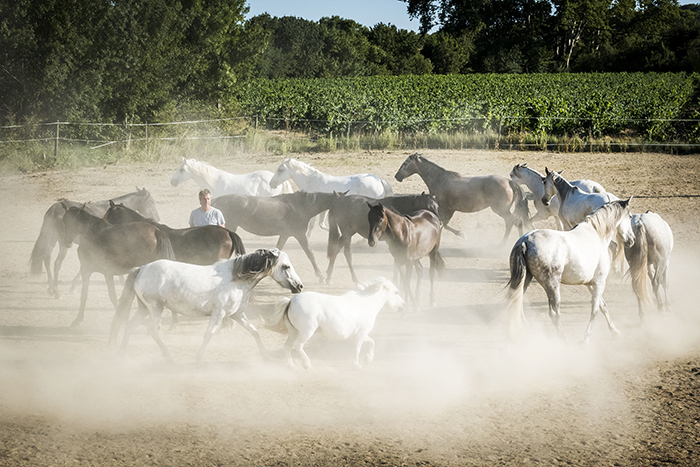 “My technique is very playful, the horses can play a little bit together. Perhaps it is a little bit more dangerous than some other methods, but I would rather go with the horses a little bit more happy and not so strict like they’re students. I prefer this because I want my horses to want to do the training. This is why I’m very happy with my last performance. The black horse, she could have gone out and left, but she stayed. When I want six black horses together, they stop eating grass and they come. I think that’s really nice.”
“My technique is very playful, the horses can play a little bit together. Perhaps it is a little bit more dangerous than some other methods, but I would rather go with the horses a little bit more happy and not so strict like they’re students. I prefer this because I want my horses to want to do the training. This is why I’m very happy with my last performance. The black horse, she could have gone out and left, but she stayed. When I want six black horses together, they stop eating grass and they come. I think that’s really nice.”
Play is a word you hear Jean Francois say a lot. His work with his horses is play, and it really does look like that. After a wonderful interview, Jean Francois and Sylvie take us out to the horses.
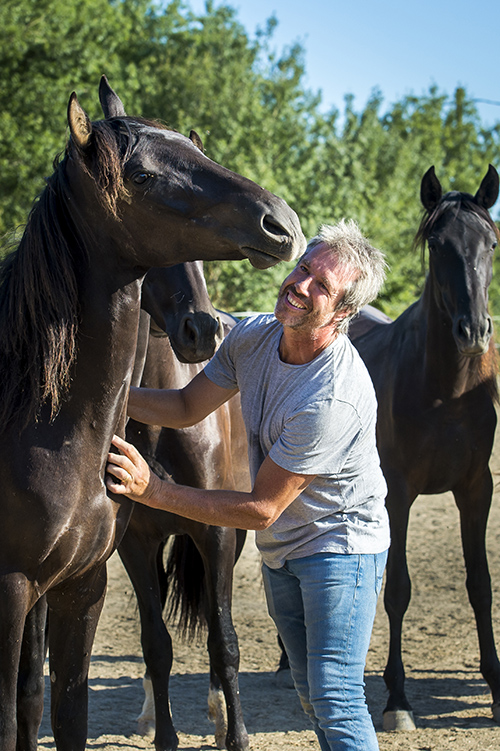
The six black two-year-olds are already in the yard when we turn up. As soon as they see Jean Francois, they are completely focused on him; they want to be with him. Like the nine greys grazing in the paddock next door. As soon as Jean Francois enters, they run up to him, waiting for instruction, but with a happy, enthusiastic, expectant manner. It’s magical to watch him interact with them. Although not huge in stature, Jean Francois is physically strong and energetically calm. His magnetism comes not from high energy but from being grounded and peaceful. He radiates safety and you can see why his horses gravitate to him.
A sweep of the hand, a look, sometimes caressing their shoulders or muzzles. That looks like all, though I’m sure there’s much more, too subtle for me to see. He smiles the whole time and looks completely absorbed with what he’s doing, completely at one with his herd. It really is beautiful to watch.
The horses are turning in two separate groups, first in a circle, then as a wheel. What was the change in aid from 20 metres away? Then they line up. It all seems like mind games to the untrained eye. There is very, very little said with words. Just a coo or a single word gently whispered, but mostly it’s just body language. When a horse steps out of formation, Jean Francois gently guides them back with his hands. It’s what every lover of horses dreams training can be. He turns and yells out to us, “My life is fantastic!”
And what does Jean François want to be remembered for? “I want humans to understand that horses are not human. You want to think that if you give your horse a carrot, it will like you. No. The horse’s life in the herd is comfortable. Sometimes it’s not nice, but he likes it. If you think he likes your world, you are not in his world. Go with a good spirit. You’re the boss with a lot of love, whether you have a problem or not. It’s harder to do that when there’s a problem, but you have to, even when it goes on for a few hours or a few days! You must make the horse calm and comfortable all the time and accept whatever happens. Perhaps it’s not an easy road, but I’m sure it’s a good road.”
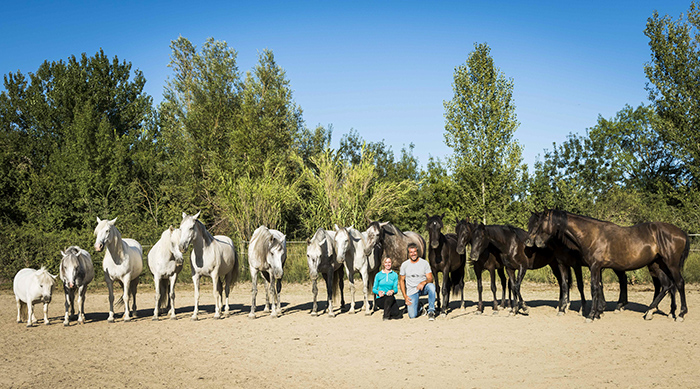
Want to breed your own dressage star? Check out Danciero – the licensing champion is by Dancier out of a Floriscount / Rascalino mare, and the semen is available from IHB details
